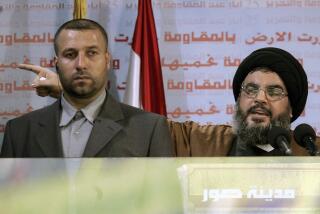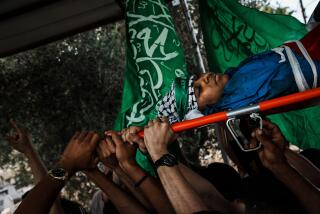Suicide Bomber Called Hero by Arabs : Lebanese Village Honors Teen-ager Who Attacked Israeli Post
- Share via
DEIR QANOUN EN NAHR, Lebanon — The walls in this hilltop Shia Muslim village are plastered with freshly printed posters of a chubby teen-ager. They proclaim him a hero three years after his death.
The posters identify him as Ahmad Khassir, a 16-year-old Muslim fighter. Lebanese guerrilla leaders, saying they now can reveal their secret, named him as the suicide bomber who destroyed an Israeli military headquarters in nearby Tyre on Nov. 11, 1982. They described it as the first suicide attack on the Israelis in Lebanon.
Initially, the Israeli military command in Tel Aviv said the headquarters was devastated by a car bomb, but later they said the explosion was caused by a gas leak.
More than 60 Israeli soldiers and 14 Lebanese and Palestinians were killed in the blast. If it was a guerrilla attack, it was one of the worst casualty tolls the Israelis suffered from such an action during their three-year occupation of Southern Lebanon.
Lebanese guerrillas and Palestinian sources have repeatedly claimed that the eight-story building was destroyed by a suicide bomber but said they had to withhold the bomber’s identity.
Officials of the radical Shia group Hezbollah (Party of God) said Khassir had requested in a tape-recorded message made before the suicide mission that his identity be kept secret for 2 1/2 years to avoid Israeli reprisals against his family.
The Israelis did make sweeps of Khassir’s village several times after the bombing, but his family was not singled out. The Israelis completed the withdrawal of the bulk of their forces last June.
In most of the suicide attacks that followed the Tyre blast, bombers were identified within hours of their strikes and hailed as “martyrs.”
Until the appearance of the posters, which show a boyish face against the smoldering ruins of the Israeli headquarters, most people believed Khassir had been captured by the South Lebanon Army, a pro-Israeli militia.
His mother, Fawzia Khassir, though, “knew I’d never see him again after he walked out of the house urging me to be courageous.”
In an interview at her small concrete-block house in this village, six miles east of Tyre, she talked about her son.
“His friends told me he was kidnaped by the Christians while on a trip to Beirut. But I knew he had died,” she said, caressing a framed photograph of her son, one of her 10 children.
“I didn’t know how or when until recently. His death and the deaths of all the others killed fighting the Israelis broke my heart. . . .”
“I never saw him with a gun. He liked to read the Koran and (Iran’s leader) Ayatollah Khomeini’s writings, she added.
“He was very brave and wanted the Israelis out of our land at any cost,” his sister Tahra added. “He did his duty as a Muslim and as a Lebanese. He is now in heaven.”
A long-haired Shia guerrilla in the nearby village of Kafra said: “Ahmad Khassir is our hero. He proved there are no barriers when one really wants to fight the enemy.
“He doesn’t have a tomb. But he’s in our hearts.”
More to Read
Sign up for Essential California
The most important California stories and recommendations in your inbox every morning.
You may occasionally receive promotional content from the Los Angeles Times.













